While the fact that airplanes have a major impact on global warming is starting to gain ground, many preconceived ideas continue to circulate, putting their importance into perspective.
It would only be “2% of emissions, whereas the Internet is 4%…”. Or it would be possible to make one long-haul flight a year without any real impact. Unfortunately, this is far from the case.
Here are ten facts and figures about airplanes and the climate, to help you sort out the facts from the figures.
1/ Aviation account for 2.5% of global emissions, but 5% of global warming
We often read that aviation is responsible for only 2.5% of greenhouse gas emissions.
In reality, this figure does not take into account non-CO2 effects. Today we know that non-CO2 effects account for between 1/2 and 2/3 of radiative forcing, which means that the role of commercial aviation accounts for around 5% of global warming between 2000 and 2018.
In other words, contrails, cirrus cloud formation and the release of water vapour and NOx at high altitudes have a positive effect on radiative forcing (i.e. a warming effect), as the IPCC pointed out in its latest report:

This phenomenon is explained in detail in this article.
2/ 1% of the world’s population accounts for 50% of aviation emissions
This is probably the most striking figure: 1% of the world’s population accounts for 50% of commercial aviation emissions.
If flying may seem normal to you, remember that it’s not for everyone. This quickly answers the argument that “air travel only accounts for 2.5% of CO2 emissions”. In relation to the world’s population, that’s gigantic.
It’s also worth noting that, according to estimates, only 2% to 4% of the world’s population took an international flight in 2018. Flying, and flying far, is a habit for only a tiny minority of the world’s population.
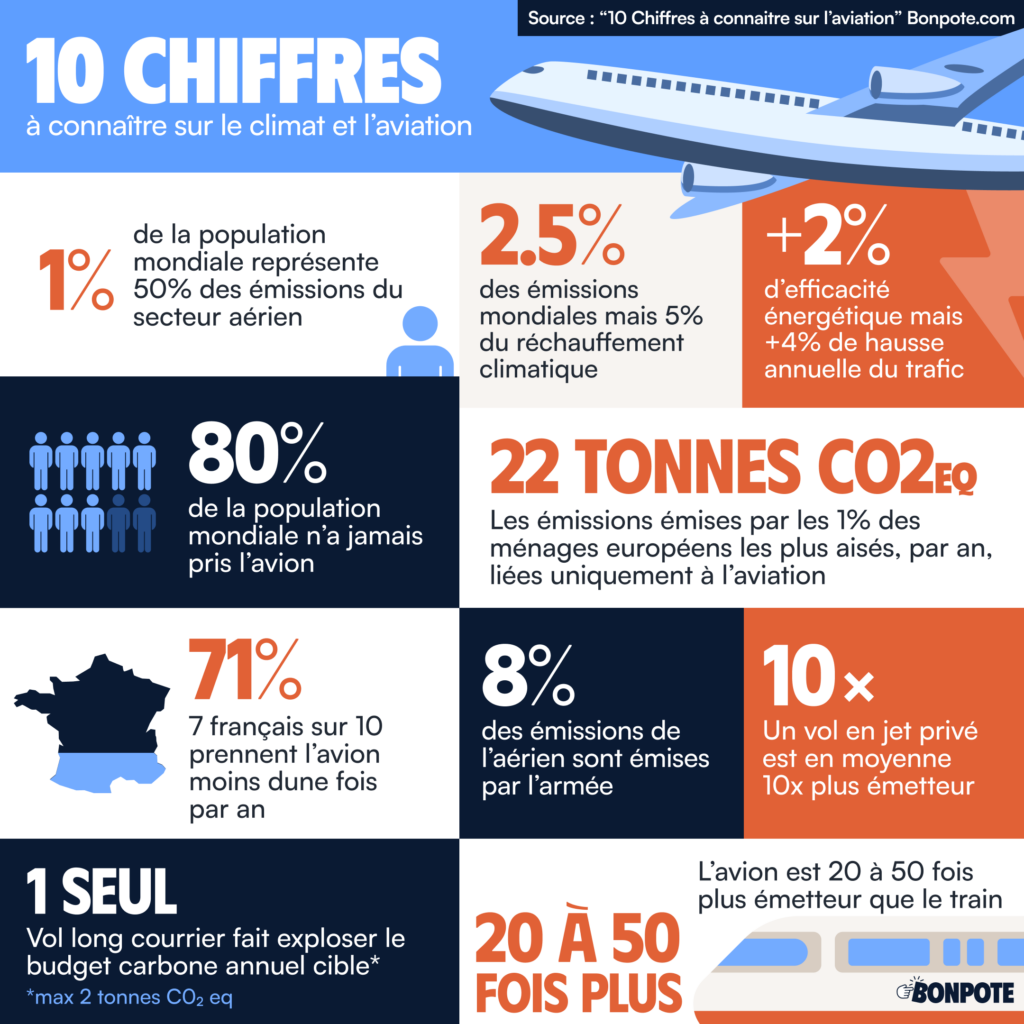
3/ 80% of the world’s population has never flown before
Every year, around 90% of the world’s population does not fly. Historically, less than 80% of the world’s population has never flown.
According to Boeing’s CEO in 2017, in a single year, 100 million Asians would be flying for the first time in their lives. The Asian market is currently driving growth in the sector. According to estimates by Gössling & al (2020), this could represent a third today to almost half of all passengers by 2050.
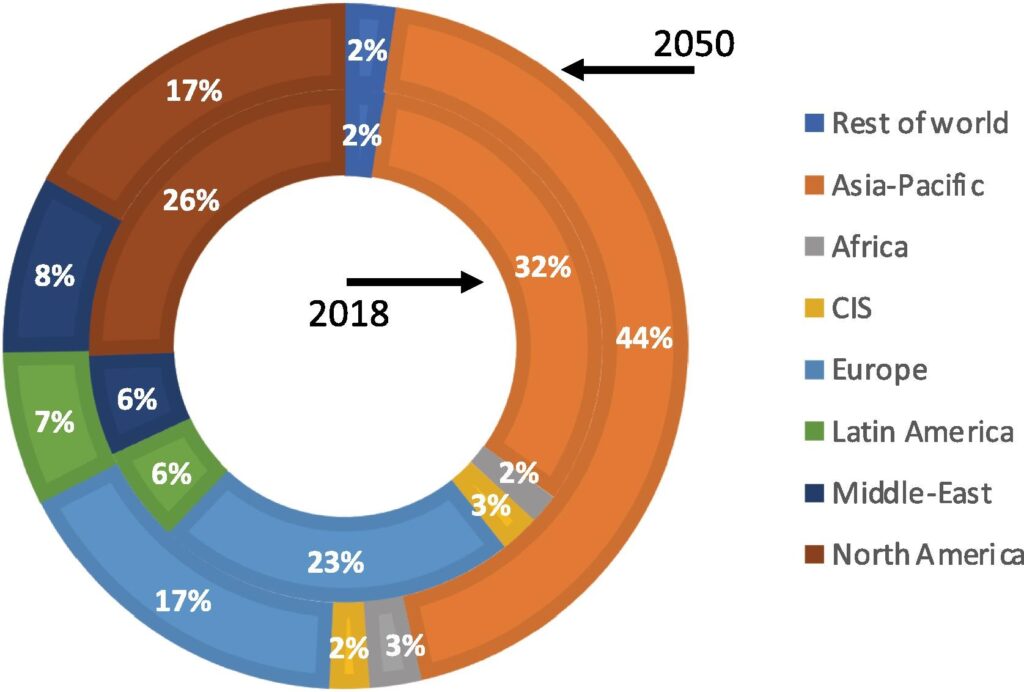
4/ Only 29% of French people fly at least once a year
Do the French fly more or less than the rest of the world? Once again, flying is not the norm. The majority of French people fly less than once a year. It’s even less than a third, according to an IFOP poll for the Fondation Jean Jaurès.
According to Ademe, by 2023, there will be a clear upward trend in the proportion of people who say they don’t fly for leisure… rising from 36% to 56% in the space of 5 years, to the detriment of other responses less favorable to this type of action.
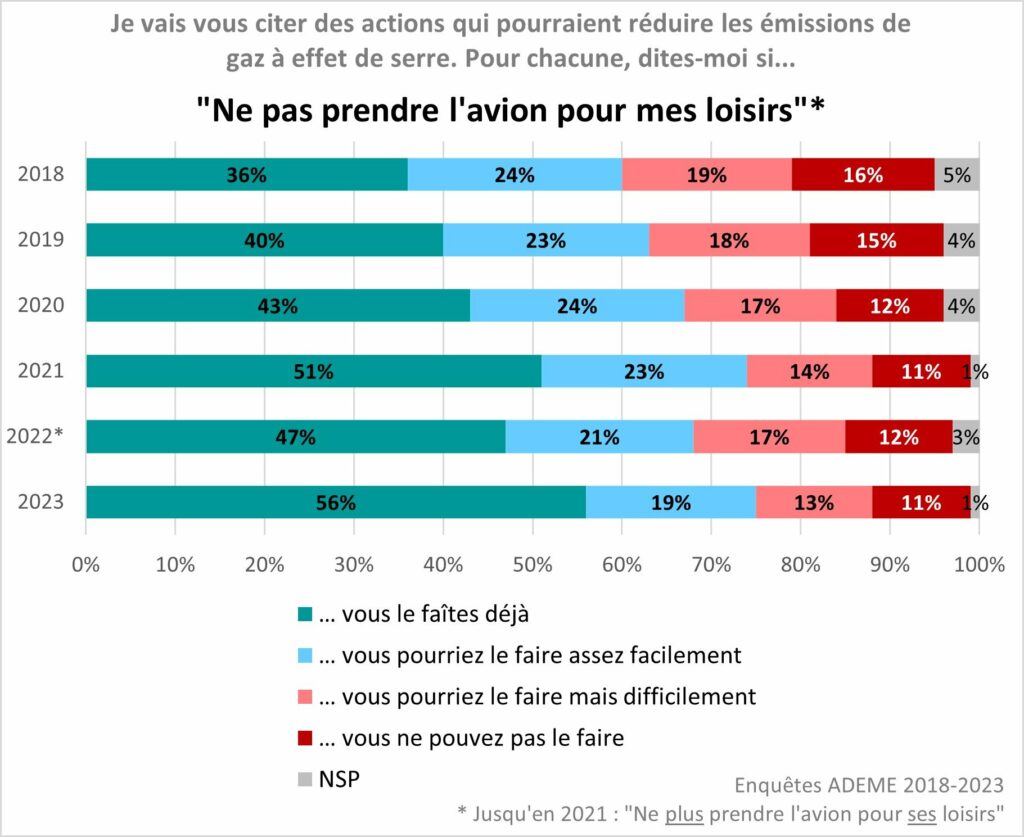
5/ Extravagant carbon footprint: 22 tonnes for the wealthiest 1% of EU households (air transport only!)
The majority of GHG emissions from the European Union’s main emitters are linked to transport, and air travel literally explodes the carbon footprint of the wealthiest households.
Air travel accounts for a carbon footprint of 22.6 t CO2eq among the wealthiest 1% of EU households, representing around 41% of their total carbon footprint. We’re talking about greenhouse gas emissions just from flying! By way of comparison, this is more than 2 times the average carbon footprint of a French person.
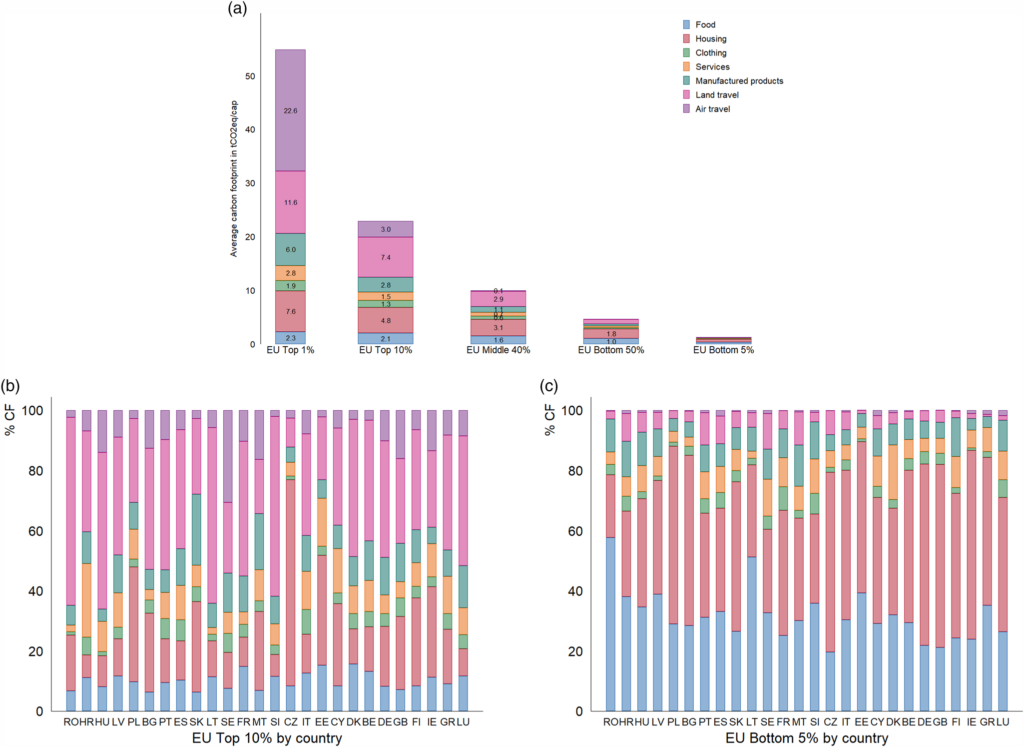
In the same study, we learn that air transport is by far the most elastic consumption in the EU, with a spending elasticity of 1.5; this means that when total spending doubles, spending on air transport increases by 150%.
This comes as no surprise, but confirms the work of Oswald & al. (2020 ): air transport is a carbon-intensive luxury.
NEWSLETTER
Chaque vendredi, recevez un condensé de la semaine, des infographies, nos recos culturelles et des exclusivités.
ALERTE
Une alerte dans votre boite mail, pour être mis au courant dès qu’un nouvel article est en ligne sur Bon Pote
6/ A single long-haul flight explodes the target annual carbon budget
This is the most important order of magnitude to remember. A long-haul flight is enough to explode your carbon footprint. A return flight from Paris to New York is equivalent to around 2 tonnes CO2eq, which is more than the target carbon budget per person for achieving carbon neutrality.
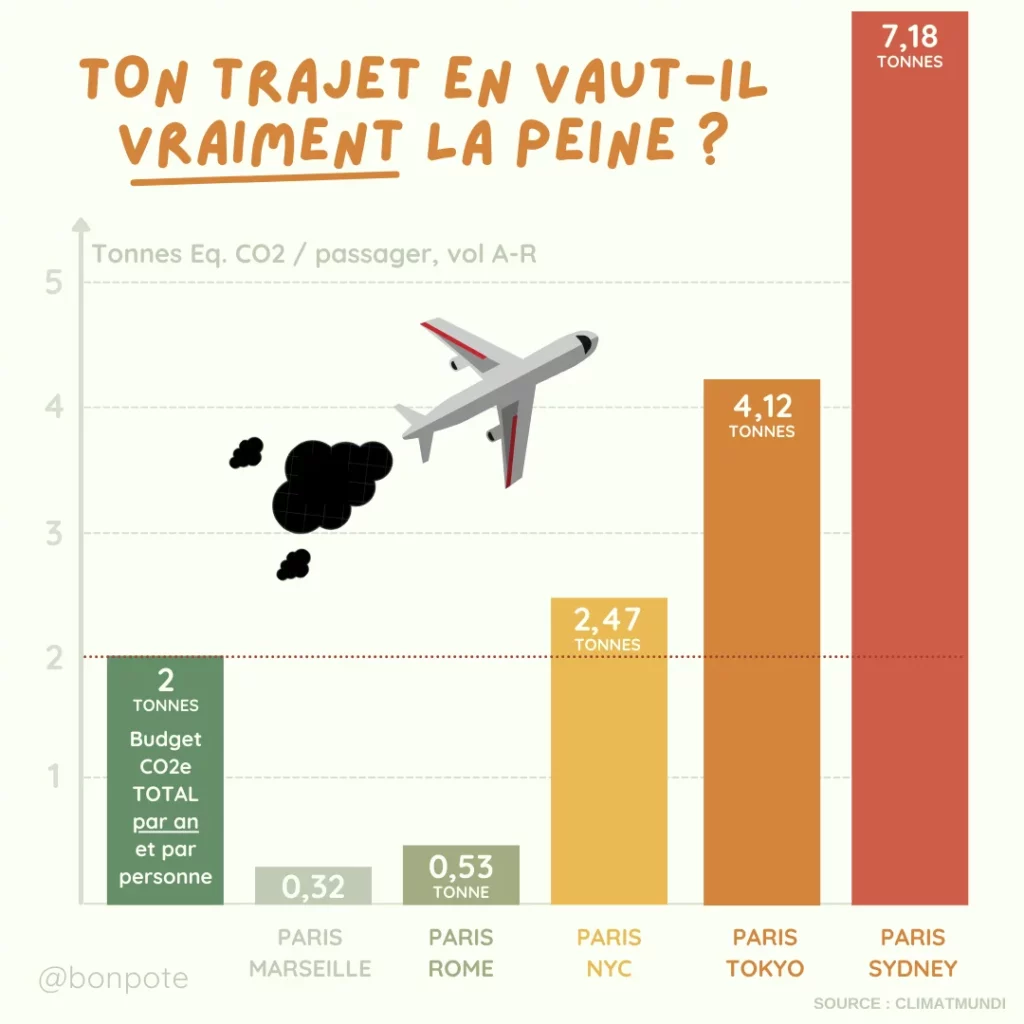
As we have seen, only 2% to 4% of the world’s population took an international flight in 2018. Like digital nomads, if this practice were to be generalized to the entire population, it would be a disaster for the fight against climate change. An opportunity to reconsider your next vacation, or the love for your favorite influencer who travels back and forth to Dubai on weekends?
7/ The armed forces account for 8% of aviation emissions
The opacity of data on non-commercial flights makes it difficult to accurately estimate greenhouse gas emissions from military operations.
For Gössling & al. (2020), the current contribution of military flights to global aviation emissions is estimated at 8%.“This estimate is uncertain, but it underlines the importance of military flights in aviation emissions.” The United States accounts for a significant share.
The authors point out that, given the strong growth in commercial air transport over the last 20 years, the share of military operations in total fuel consumption can be expected to have fallen.
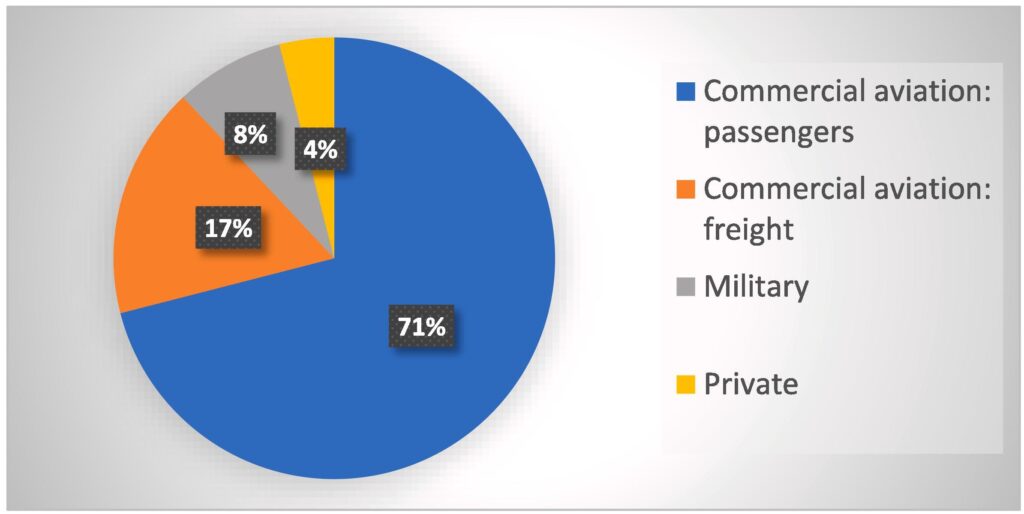
The global scale, distribution and growth of aviation: Implications for climate change
These estimates underline the importance of including all industries in the ecological transition. In a carbon-neutral world, where would the army fit in?
8/ A flight in a private jet emits on average 10x more greenhouse gases.
An exhaustive report was published by Transport & Environment in 2021 and we can retain several key points about private jets:
- Private jets are on average 10 times more polluting than commercial aircraft (per passenger). This gap will widen as private jet users switch to larger and more polluting aircraft than their commercial alternatives.
- In one hour, a single private jet can emit two tonnes of CO2. The average annual emission for a European is 8.2 tonnes CO2eq, while that for a French person is around 10 tonnes.
- In 2019, one in ten flights from France was by private jet, and half were less than 500 km. Remember that the shortest flights are the most polluting per km travelled.
- The average private jet owner has a fortune of 1.3 billion euros, and France and the UK dominate the private jet market. Flights from these countries each emit more CO2 than 20 other European countries combined.
- Nice is one of the top 10 airports for private jets. This confirms that private jets are used by the wealthy to enjoy the sun and splendor of Nice, and not so much for business…
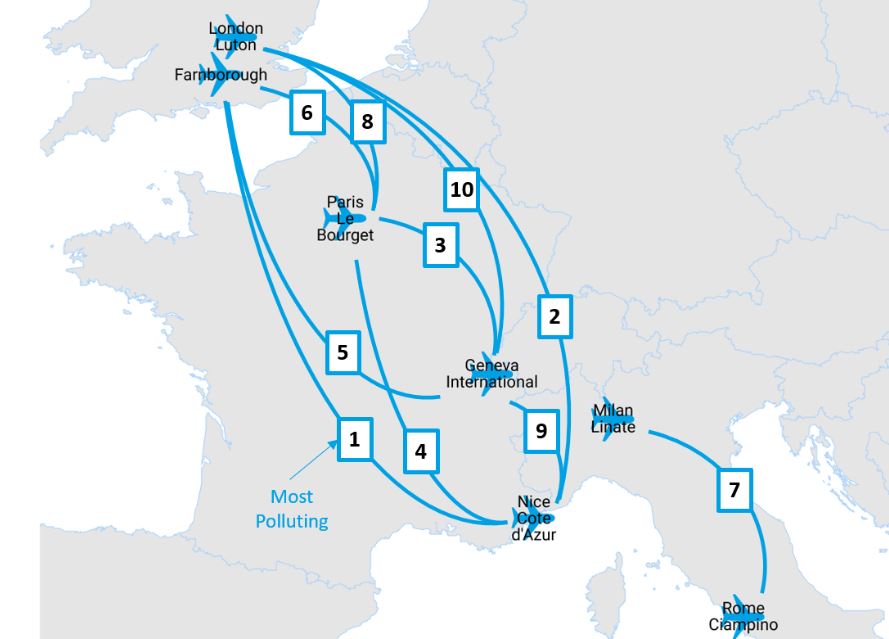
Given that private jet flights are exploding our carbon footprint, it makes perfect sense to reduce or even ban their use. Without social justice, there can be no ecological transition. This is reiterated by the IPCC, the French High Council for the Climate, etc.
9/ Planes emit 20 to 50 times more CO2 than trains
As you now know, the bill would have to be at least doubled if we were to take into account the real impact of air travel on global warming. But even taking only CO2 into account, air travel emits on average 20 to 50 times more CO2 than rail travel.
Whatever the type of train and the routes taken, rail is unbeatable in terms of CO2 emissions compared with air travel. This is thanks in particular to France’s electricity mix, which is one of the most carbon-free in the world, and to its carrying capacity, with duplex TGVs that can carry over 1,000 passengers.
10/ 2% energy efficiency, but 4% annual traffic growth
According to Sacchi & al (2023)Although aircraft fuel efficiency has improved by 2% per year over the past two decades, CO2 emissions have continued to rise due to a 4% increase in annual demand, doubling aviation’s contribution to global anthropogenic CO2 emissions (with the exception of temporary reductions due to COVID-19).
TheGlobal Carbon Project’s (GCP) annual 2023 baseline study shows that emissions from international aviation have continued to grow after the trough of the pandemic, and are expected to increase by 28% compared to 2022.
As demonstrated by the study Howto makeclimate-neutral aviation fly, not limiting air traffic demand would make carbon neutrality highly unlikely, not least because it would rely on a very large amount of carbon dioxide removal, the effectiveness of which has yet to be proven. Greedy for electricity, fresh water, land, etc.
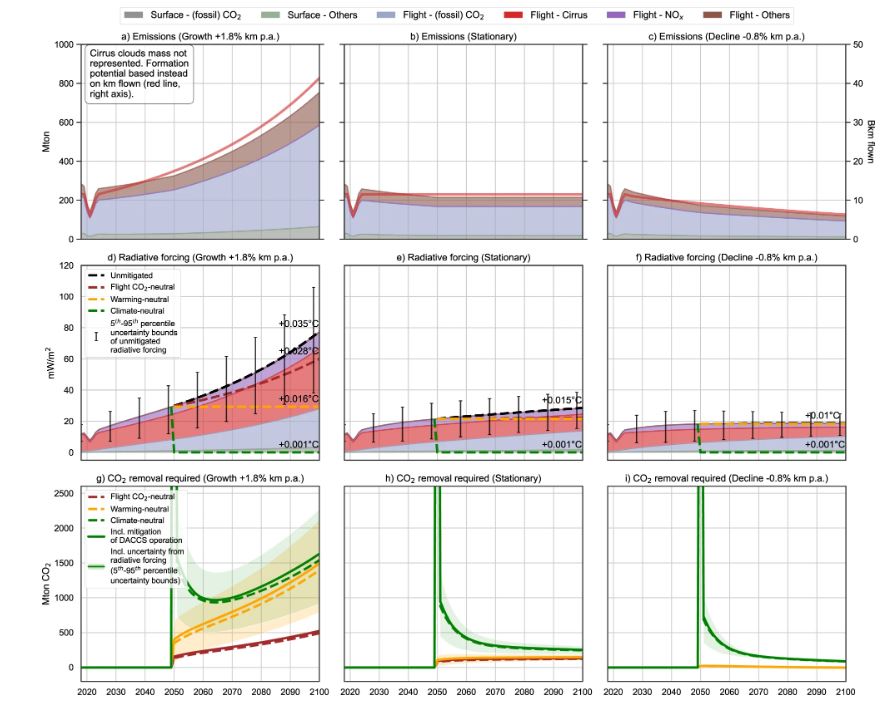
The study also shows that maintaining the level of fossil kerosene and combining it with DACCS would simply be too much CO2 to store. The same logic applies to synthetic kerosene, which requires less DACCS to eliminate residual emissions: too much electricity, water and land in return.
A carbon-neutral world with air traffic more than doubling by 2050 – who can really believe it?
If our relationship with airplanes doesn’t change…
If we’re going to discuss our future democratically, we might as well base our discussions on concrete, reliable facts. That was the aim of this article: to set out the orders of magnitude and the limits of certain arguments that seek to minimize the impact of air transport on global warming.
It’s important to note that exact air traffic figures are sometimes difficult to obtain. Both nationally and internationally. This is confirmed by Yoann Demoli and Jeanne Subtil’s investigation, who also had great difficulty in obtaining the figures from the DGAC, the French Civil Aviation Authority.
Other trends could have been highlighted. For example, the fact that young people represent the age category that takes the most air travel, something that doesn’t improve with influencers who continue to make their community win air travel on networks like Instagram or Tik Tok.
As long as flying around the world to take selfies is valued, the world will continue to warm up. Public authorities urgently need to bring about structural change, notably by taxing aviation kerosene and investing massively in alternatives such as rail.














One Response
Bonjour,
Quelle est votre source pour cette affirmation?
3/ 80% of the world’s population has never flown before
Every year, around 90% of the world’s population does not fly. Historically, less than 80% of the world’s population has never flown.